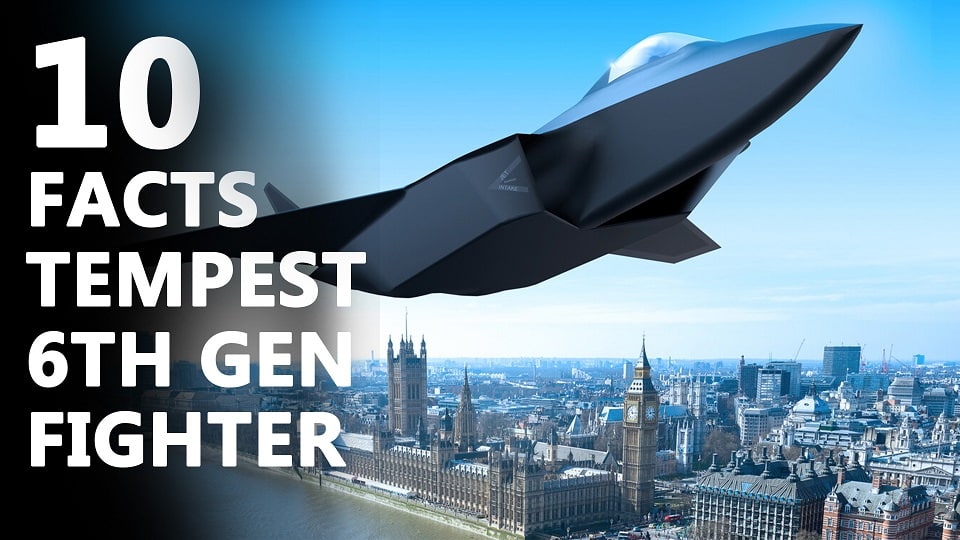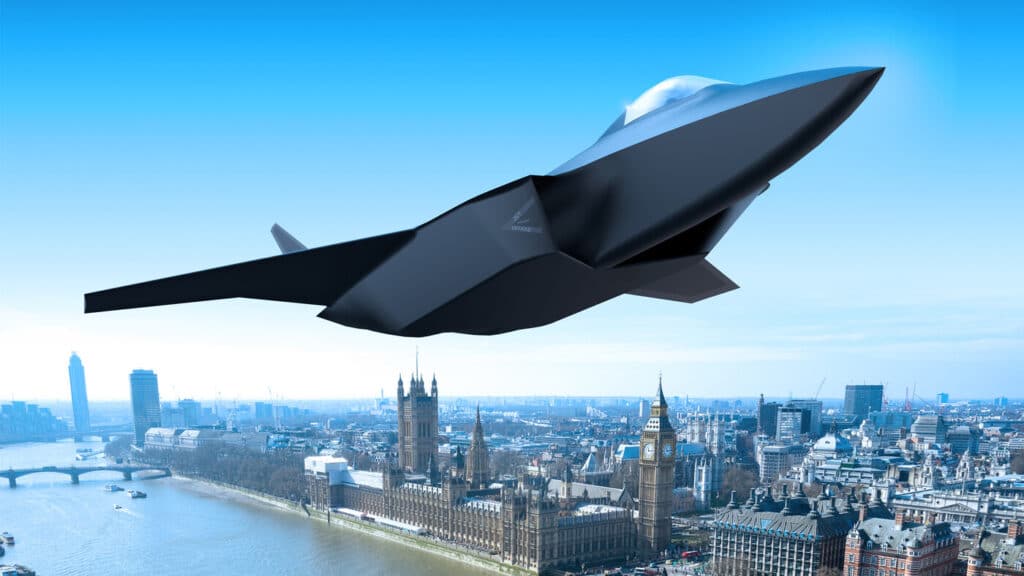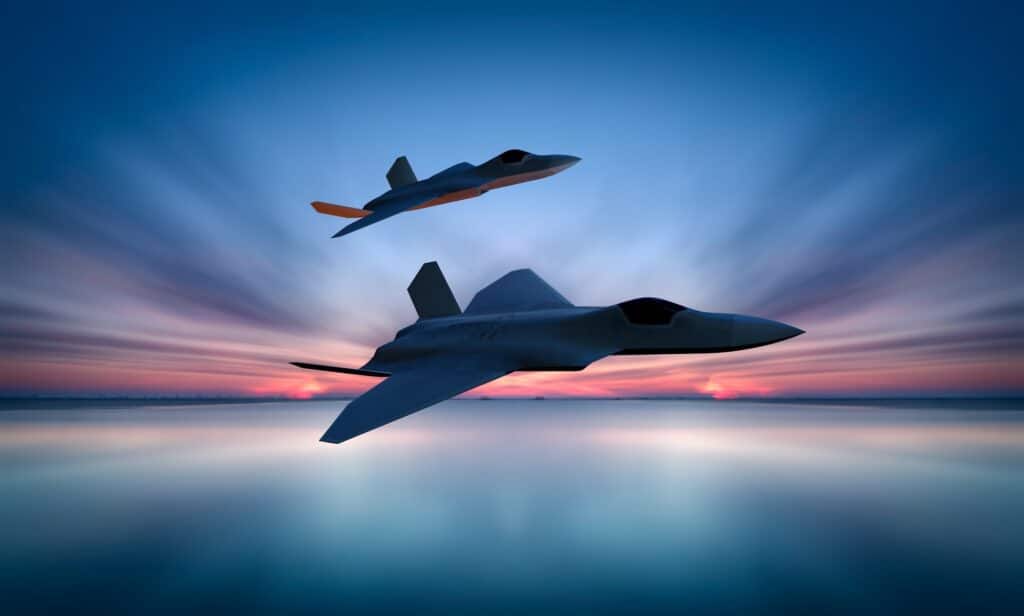Aerospace
10 Facts about the Tempest 6th gen fighter jet.

we’ll look at 10 fascinating facts about the sixth-generation fighter plane that the UK, Japan, and Italy are working to develop.
1. UK, Italy, and Japan announced a sixth-generation fighter.
The UK has revealed plans to produce the 6th Generation fighter jet in cooperation with Japan and Italy with a shared ambition to develop a next-generation fighter aircraft as part of a new Global Combat Air Programme (GCAP). It is a more lethal combat jet now that the UK and Japan have finished developing cutting-edge technology.
Meet Japan’s 6th Gen Fighter jet and its mind blowing features(Opens in a new browser tab)
2. The UK has a number of superpower corporations, including RR, MBDA, and BAE.
The program is being developed closely in conjunction with the BAE System, which offers an electronic system, the MBDA, which offers next-generation armaments, and Rolls-Royce, which is producing the aircraft’s engines. A number of next-generation future combat air system capabilities are currently being evaluated and developed by the UK under the Tempest program, which is already in the development phase of the 6th generation fighter jet.
UK industry to play key role in new Global Combat Air Programme(Opens in a new browser tab)
3. Fighter aircraft with a loyal wingman.
Global Combat Air Program This aircraft will operate under the crew and uncrewed system that can be operated under the closed network group, just like every other sixth-generation fighter. “Loyal Wingman” platforms will be a part of a micro air group in a system of systems strategy.
4. The key technology birth is GCAP vs. FCAS.
The FCAS program is being created by the Airbus team with assistance from France, Germany, and Sweden, as the European Union declared, in order to compete with the GCAP program, which is being developed under the guidance of the United Kingdom. Although the two fighter jets will share certain similarities, they will have different qualities. The UK will profit financially from this investment in aircraft development and pick up new capabilities for building planes.
5. The best technology for fighter jets will be brought in large part by Japan.
Japan has already developed and built a number of demonstration aircraft. The first experimental Stealth technology demonstration for the sixth generation of aircraft is the Mitsubishi Heavy Industries-built X2. This aircraft is used to learn stealth technology and prototypes. The X-2 successfully completed its first flight on April 22, 2016, flying from Nagoya Airfield to the JASDF’s Gifu Air Field.
6. For this fighter, Japan is introducing 3D vector thrust technology.
This aircraft’s engine nozzle, which includes 3D thrust vectoring similar to the system used on the Rockwell X31, is being added by Japan. This allows for quick aircraft movement and supports a variety of flight trajectories. Additionally, thanks to the display of fly-by optics, a capability unique to this aircraft, the data are processed 100 times faster than with wires. Due to its immunity to electromagnetic interference, it has benefited.
7. This aircraft has an automatic repair flight control system.
Additionally, Japan adding This aircraft also has the capacity to repair its own flight controls, enabling it to detect flaws or damage to its flight control surface on its own. maintain, adjust, and carry out controlled flight. It will have a radar system that is comparable to the F 35’s. Japan has conducted research on the airframe construction of its aircraft, eliminating fasteners and replacing them with solid adhesive bonding. Additionally, its surface will have a special covering that can lessen radar reflection.
8. Incoming missiles are deflected by microwave weaponry.
A microwave weapon will also be placed on the F-X by Japan in order to deflect incoming missiles. This aircraft has a drone control system that interacts with the Boeing wingman drone control system. When compared to using drones, which can be fired from an aircraft’s weapons bay to reach and target the enemy at a great distance, this will be a breakthrough in operating a greater range.
9. The initiative will enable the UK to create 21,000 employees in ten years.
How the UK benefited from the initiative. It will gain knowledge of the creation of airplanes as well as rights to patents on the technology, which may potentially lead to the development of other products. It will also create 21,000 jobs in the next 10 years and strengthen the economic reform of exporting such goods. As part of the agreement, the bulk of aircraft will be developed in the United Kingdom.
10. Tempest will replace their fighter in the UK, Japan, and Italy.
The addition of Japan will also increase economies of scale, as its own F-X sixth-generation fighter program was intended to replace about 90 F-2 planes starting in the mid-2030s. With the potential for up to 100 aircraft, the UK has long been aiming to replace its Eurofighter Typhoon FGR4 platform with what is now the GCAP starting in the middle of the 2030s. The GCAP will also take the place of Italy’s Eurofighters.

Aerospace
Which is bigger 777x or 787 aircraft ?

The 777X is a new series of the Boeing 777 family and is designed to be larger and more efficient than its predecessor. It features two variants: the 777-8 and the 777-9, being the larger of the two.
The Boeing 777X emerges as the larger sibling within the Boeing family, representing a significant leap forward in both size and efficiency. Comprising two variants, the 777-8 and the 777-9, the latter takes the crown as the larger of the two. With its expansive fuselage and impressive wingspan, the 777X is tailored for long-range journeys and boasts a substantial passenger capacity.
On the other hand, the Boeing 787, affectionately known as the Dreamliner, occupies a niche in the market as a smaller yet formidable aircraft designed for medium to long-range flights. Its distinguishing feature lies in its composite fuselage, a technological marvel that renders it lighter and more fuel-efficient compared to conventional aluminum counterparts. The Boeing 777X is larger than the Boeing 787 aircraft.
When it comes to passenger capacity, the 777-9 reigns supreme, typically accommodating a sizeable contingent of 400-425 passengers in its standard configuration. In contrast, the 787, with its more modest dimensions, typically carries between 240-290 passengers, depending on the variant and layout.
One of the remarkable innovations introduced with the 777X is its folding wingtips, a feature designed to address the logistical challenges of accommodating such a large aircraft in conventional airport gates. These folding wingtips enable the 777X to retract its wings, allowing it to fit into gates designed for smaller aircraft while still reaping the benefits of an extended wingspan during flight, thereby enhancing fuel efficiency and operational flexibility
Aerospace
China Secures Production Certificate for Mass Production of Pilotless eVTOL Aircraft

The first passenger-carrying pilotless electric vertical takeoff and landing (eVTOL) aircraft in the world, the EH216-S, has received the Production Certificate for its eVTOL aircraft from the Civil Aviation Administration of China (CAAC).
This is a significant milestone for EHang Holdings Limited, the leading UAM technology platform company in the world. This outstanding accomplishment is another big step towards mass manufacturing for the eVTOL aircraft and the ensuing commercial operations, building on the ground-breaking acquisition of the Type Certificate and the Standard Airworthiness Certificate for the EH216-S.
The PC is a crucial certificate that the aircraft maker receives from the CAAC, the country’s aviation authority. By obtaining this certificate, EHang has demonstrated that it has set up a quality management system for mass production that satisfies the airworthiness regulation standards set forth by the CAAC, and the company has been given permission to continue producing mass quantities.
It is also a strong guarantee of the calibre of the goods made by EHang. Raw materials, supplier management, manufacturing organisation, production quality control, aircraft pre-delivery test, after-sales repair and maintenance, etc. are all included in the mass production quality management system for the EH216-S.
To ensure that every aircraft and its components that roll off the production line strictly adhere to the approved type design and safety requirements, the system sets clear guidelines and documentation for every step in the production procedure. This ensures comprehensive traceability and safety control.
Aerospace
Four Airbus A380 Superjumbos lined up to be scrapped

In a strategic move aimed at reclaiming valuable resources from the iconic Airbus A380 aircraft, VAS Aero Services and Dr. Peters Group have announced a significant collaboration.
This partnership marks a milestone in aviation logistics and aftermarket services, with four of these colossal planes slated for teardown and redistribution of used serviceable material (USM).
The venture between VAS Aero Services, renowned for its expertise in aircraft dismantlement, and Dr. Peters Group, a prominent Germany-based investment fund management firm, underscores a commitment to sustainable aviation practices. This isn’t their first foray into scrapping A380s; their successful partnership has already seen the dismantlement of these aircraft, making them pioneers in this niche.
Under the agreement, the latest consignment brings the tally to eight A380s entrusted to VAS by Dr. Peters Group. Managing Director Christian Mailly of Dr. Peters Group emphasized the trust placed in VAS, citing their unparalleled capabilities in dismantlement and aftermarket sales network. It’s a strategic move in response to the growing demand for quality USM parts, particularly with the resurgence in reliance on the A380.
Notably, the teardown process will be carried out at various locations, optimizing the positioning of harvested parts to cater to different markets. While some parts will be positioned in Europe to support operators in the region and the Middle East, others will remain in the Asia-Pacific region. This meticulous strategy ensures efficient access to spare parts, benefiting MROs and airlines across these markets.
The decision to retire these A380s comes at a time when operators are reassessing fleet strategies amidst evolving market dynamics. Despite initial plans for quick retirement due to the emergence of more fuel-efficient alternatives, factors such as a rebound in long-haul demand and delays in new widebody deliveries have prompted operators to reconsider. The A380, with its unique capacity and capabilities, presents a practical solution for short-term capacity management.




























